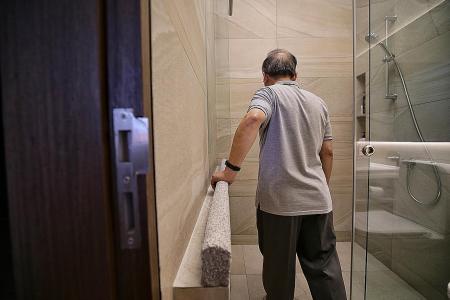Design features to consider for an elderly-friendly home
Adequate lighting is a big plus, while loose carpets and door knobs can be a hazard or hindrance
Whether you are living with older folks or helping elderly parents to update a space, the decor of their home may need to be modified to suit their needs and comfort.
Many active seniors appreciate independence. They should be able to carry out their activities - from going about household chores to maintenance - with ease and simplicity.
Here are some design and furniture ideas for creating an elderly-friendly home:
Keep the floor level
Raised flooring like thresholds and steps can be a hazard that leads to tripping.
Mr Ivan Lin, interior designer and director of Aart Boxx Interior, said: "Keep flooring as levelled as possible and avoid curbs or raised platforms. If flooring of different heights is required, consider a ramp instead."
This is especially useful if there is someone at home who requires a wheelchair.
Consider anti-slip floor tiles or treatments
Tiles like marble and polished stone flooring may look great, but they often do not offer enough grip, which can lead to slips and falls. Especially in the bathroom and kitchen, non-skid tiles should ideally be installed.
Mr Lin said: "Even so, rough tiles can be slippery when they come into contact with water and soap. Homeowners can consider applying a nano anti-slip treatment, a solution that increases friction even when the floor is wet or soapy.
"However, it should be reapplied every two to three years."
Install railings or grab bars
At the same time, think about installing rails in the bathroom for extra support. These are also useful in walkways and if your home has stairs or steps.
Bathrooms can be outfitted with benches or shower chairs to make for a more comfortable and safer showering experience.
Be mindful of sharp edges
Not only should the placement of furniture not hinder seniors' movement, but do take note of items with sharp edges.
Compact, rounded furniture pieces create more room for movement, and are less dangerous.
Avoid loose carpets
Carpets and rugs feel soft and snug under the feet, but can also contribute to the risk of falls if they are loose or have curled edges. If the senior resident prefers to have them, add anti-slip rug underlays to keep them in place.
Adequate lighting
Ageing often comes with changes in vision and eye ailments. Sufficient and even distribution of ambient lighting without glare is crucial - think brighter, cooler lights rather than dim, yellow lights.
Focused lighting inside cupboards or at functional areas such as over counter tops can be useful for easily locating items and preventing accidents.
Such lights can be made easier on a senior's eyes if the intensity and direction are adjustable.
Also, light switches should be placed within reach (or an arm's length) of the entrance.
Avoid clutter and create accessible storage
Having clutter around the home increases the risk of bumping into objects, and requires extra time to look for items. While you would want sufficient storage, keep it accessible. Base cabinets with drawers and long wall cabinets make it easy to retrieve items without having to stretch, or climb on a stool.
Opt for furniture with height and support
When it comes to chairs, sofas and bed frames, choose ones with adequate height so elderly folk can get up or sit down with ease.
Chairs and armchairs should ideally have a backrest high enough to provide lumbar support - skip those with uncomfortable straight backs.
A footstool is also great for propping up feet to improve blood circulation.
Replace door knobs
For ageing adults with arthritis, doorknobs can quite literally be a pain. Replace them with levers to make it easier for seniors.
This article was first published in The Singapore Women's Weekly (www.womensweekly.com.sg).
Get The New Paper on your phone with the free TNP app. Download from the Apple App Store or Google Play Store now


